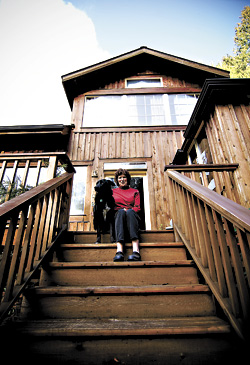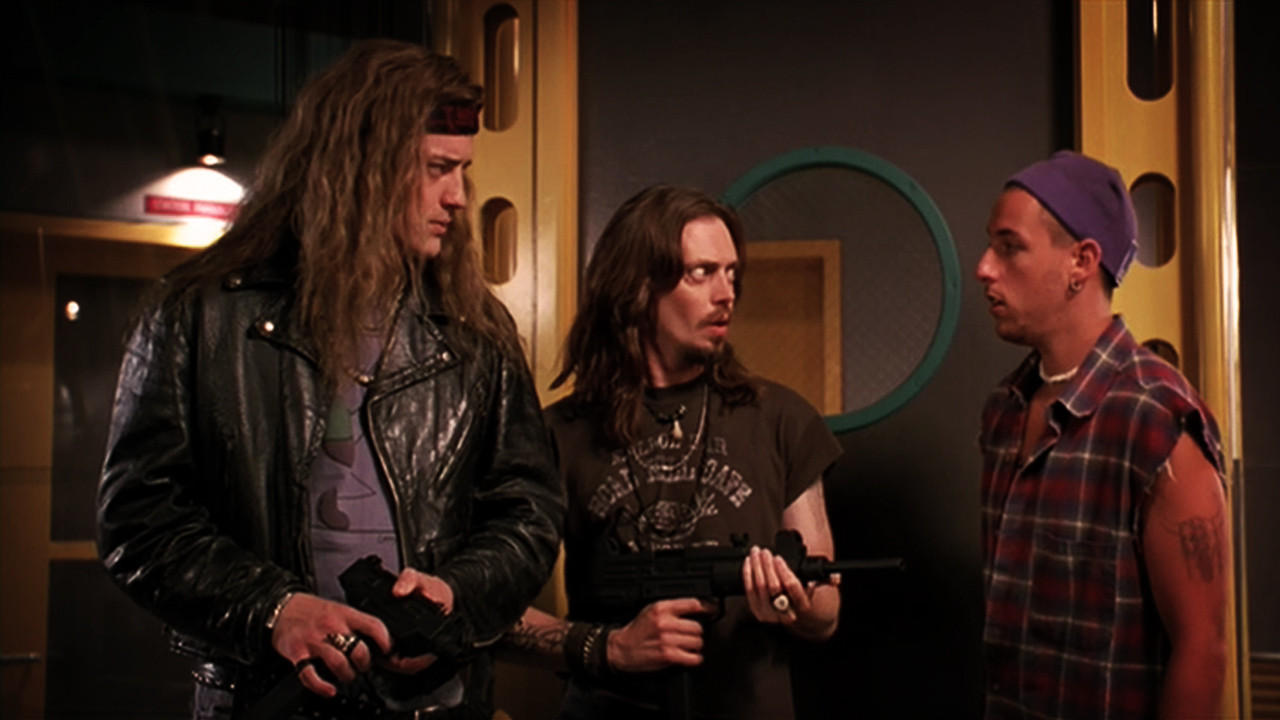Rain and slush pound the downtown pavement on a cold December Sunday in Bremerton, where a few proud members of this town’s working class are huddled beneath the awning of the Drift Inn, trying desperately to stay dry while sucking down cigarettes.
The Drift Inn sits across the street from the Puget Sound Naval Shipyard (PSNS), the place of business for several of the convened smokers and thousands of others in the region, including Seattle. Adjacent to Kitsap County’s largest employer is the Bremerton ferry terminal, gateway to day jobs for another chunk of the county’s population (including this reporter). As the crow flies, Bainbridge Island is barely three miles away. As the car drives, however, it can take an hour.
It doesn’t happen very often, but occasionally, according to Aaron Bausch-Green, Islanders catch the boat from Bremerton to downtown Seattle. “You can always tell a Bainbridge Islander at the ferry terminal, especially if you’re smoking,” says Bausch-Green, an art framer who has temporarily abandoned his hot toddy. “They’re the first ones to give you a dirty look. I’m sure there are a lot of nice people who live on Bainbridge Island, [but] most of the ones I’ve met are real tight asses. They’re just snooty. It’s like they don’t want to be here. They’re slumming.”
One recent morning on Bainbridge Island, the boomer clientele at Andante Coffee is listening to Jack Johnson and the Steve Miller Band. Take a few steps toward Eagle Harbor and you can see the healthy live-aboard community, a perennial thorn in the sides of homeowners who invested in a view that extends all the way to Seattle.
Libby Anderson is a librarian who has lived on Bainbridge since 1977. Back then, she says, “you could roller-skate down Winslow Way on a summer afternoon and there wouldn’t be traffic.” Cross the street today and you’re likely to play chicken with a BMW, Volvo, or Prius that can’t be heard through the headphones on your iPod. Anderson loves her island, and has nothing against Bremerton, but, like every other person who was interviewed for this story, she recognizes a palpable rift dividing the two communities.
They’re in the same county, share the same courthouse, and are separated by less than a mile of water. But for many of the roughly 60,000 residents who call Bainbridge and Bremerton home, there’s been a chasm, sometimes real, sometimes purely perceived, between them. Islanders, so the story goes, are the rich elitists who make local calls to Seattle and would rather be part of the King County conversation than that of Kitsap. Then there’s Bremerton, cast as a Navy town with stabbings, ax murders, cheap housing, and a fondness for NASCAR.
Nothing articulates the perceived class struggle as well as the ferry system. Whereas Islanders get the nice boats, the quick, 35-minute rides, and the frequent trips, Bremerton commuters spend two hours a day on board and have to choose between the 10:30 p.m. and 12:50 a.m. boats during Mariner games. They’re also stuck with the leftovers, literally. The Hyak, which was only good enough to sub for the Bainbridge run until it got new boats in 1998, is a Bremerton regular, and was pulled from the route in the middle of the day recently for rudder repairs, canceling several sailings.
Because of disparities such as these, every few years the class war between the two communities flares up again, whether it’s about a bridge, beach-eroding foot ferries, a NASCAR track, or wireless Internet. It’s not exactly a feud, nor an enduring conflict, as you’ll be hard-pressed to find a person in Bremerton who flat-out hates Islanders. You’ll be equally challenged to find an Islander who admits they do their best to ignore their blue-collar neighbors to the south. But you could go all day without finding a member of either community who is ignorant of the divide.
“To a big extent it has to do with money,” said Julie McCormick, a reporter who covered Bainbridge Island in the late ’80s for the Kitsap Sun, the region’s daily newspaper. “I mean, [Islanders are] richer. They’re also politically liberal compared to other parts of the county. The county’s more militarily oriented. It does boil down to class as much as anything.”
Lance Sutton is finished with his beer and his day at the office, and the Chelan ferry is carrying him home to Bremerton from downtown Seattle’s Colman Dock. Sutton lives in Manette, a neighborhood within walking distance of the ferry terminal, and he doesn’t need a car to get to his IT job at a major financial corporation in Seattle.
If Sutton lived on Bainbridge and commuted from the island’s downtown Winslow district, he’d only be on the water for 35 minutes each way and would be riding the nicest boats Washington State Ferries has to offer. “What is it with Bainbridge always getting all the best?” Sutton wonders aloud. “It does seem like the ferry system is bending over backwards to give the Bainbridge Island executives all the perks.”
The Bainbridge route has had Wi-Fi since a pilot program was rolled out in 2005, yet riders like Sutton and the regulars on WSF’s 55-minute run didn’t receive Wi-Fi until last week. Parsons Corp. currently provides service, and the Bainbridge route has had access to the Columbia Tower’s signal. But Parsons had a harder time getting a signal to reach all of Rich Passage, the winding, narrow body of water upon which the Bremerton-bound boats run between Bainbridge, Manchester, and Port Orchard. Service was set back several times, once when the city of Bainbridge denied Parsons’ request to put an antenna on a pole because it was within 200 feet of Bainbridge’s shore. Parsons says it has since found alternate locations on the island for antennas.
But the Wi-Fi situation is not the ferry issue that has most stoked the perceived classism. That would be Bremerton’s fast foot ferry, or lack thereof.
Washington State Ferries operated a passenger-only ferry in the 1990s that took 28 minutes from downtown Seattle to Bremerton, which at the time was sporting houses for less than $100,000. With home prices around the Puget Sound beginning a steep climb, the city that many had left for dead when the town’s retail moved out to Silverdale’s mall in the mid-’90s was looking pretty good. Bausch-Green, who has called the Puget Sound area home most years since 1978, picked Bremerton upon his return from the Midwest for its affordable housing and the ferry ride to downtown that was tantamount to “a bus ride to Ballard.”
But in 1999, thanks to a lawsuit led by Bainbridge Island homeowners along Rich Passage, who claimed their beaches were eroding due to the 350-passenger foot ferry’s wake, the state slowed the route down to 36 minutes (which probably seems pretty speedy given the current hour-long commute). The route consequently lost popularity, with WSF discontinuing service altogether in 2003, citing budget shortfalls. (Kitsap Transit and the private Kitsap Ferry Co. operated $14, 80-minute round-trip runs twice a day until spring of 2007; publicly operated ferries cost $6.50 for a passenger-only fare.)
To many Bremertonians, including Bausch-Green, Bainbridge was to blame for the loss of their quick ride to downtown. “You can bet if those motherfuckers had [a fast foot ferry], you’d be hard-pressed to shut them down,” he says. “They don’t need it. They’re close enough. If you can afford waterfront property, you should be able to afford to shore it up.”
But not all Bremerton residents point their fingers at the Islanders. Sutton, for one, says if he had been in the Bainbridge homeowners’ position, he probably would have done the same thing. Alan Davies, who lives near downtown Bremerton’s Evergreen Park, doesn’t blame Islanders either. He blames the Legislature—and the WSF.
“The reason that [the Rich Passage homeowners] won was because of the low quality of lawyers arguing for the ferry system,” says Davies at Fraiche Cup, a downtown Bremerton coffee shop. “People follow their own narrow intentions. And the people in Rich Passage wanted it the way it always was.
“If Bremerton had managed to keep [the foot ferries], there would be probably 10 construction cranes around Bremerton right now,” he adds. “There was a strategic mistake made. Bremerton renewal actually came to a dead stop in 2002, but not the housing bubble. Because of the national and international housing bubble, the Bremerton renewal was able to take place.”
Cary Bozeman, the former mayor of Bellevue who’s served as Bremerton’s mayor since 2002, says losing the foot ferries threw a wrench into his plans to revitalize the downtown of a city that had seen a decade of decline, losing core retail anchors like J.C. Penney to nearby Kitsap Mall. In the past five years, however, downtown Bremerton has gotten a new convention center, hotel, waterfront park, government center, and Anthony’s HomePort restaurant.
Bozeman says he can still accomplish his mission of making Bremerton a destination without a fast foot ferry, but he doesn’t think he’ll have to. “We’d have to be idiots not to be able to figure this out and do it. And we’re not idiots,” he says. “So I don’t even consider for a minute that we won’t be able to reinstate [a foot ferry]. I think there’ll be passenger-only ferries between Everett and Seattle, Tacoma and Seattle, Port Orchard and Seattle, Bainbridge and Seattle. I don’t have any doubt that the mosquito fleetis a great idea. There are a lot of ways to make this work.”
Bainbridge’s downtown Winslow district is flush with glossy new condos, not unlike Ballard and Capitol Hill. What used to be blackberry bushes and a parking lot a stone’s throw from the ferry terminal is now Harbor Square, with 180 condo units, a wine shop, a natural foods market, and a furniture store. Winslow has always been a hotbed for commuters, but the new housing developments are making it, in many ways, an ad hoc Seattle neighborhood.
As Bainbridge has lost its rural, small-town feel, it’s become, some would say, a self-sustaining island, where residents pride themselves on doing all their Christmas shopping without the aid of a bridge or ferry. On the afternoon that I visit Bainbridge Island’s mayor, Darlene Kordonowy, there is a front-page story in the Kitsap Sun about Nat Hong, a Bainbridge resident who pedals his water bike across Rich Passage every day to his job as an English teacher at Bremerton’s Olympic College rather than drive. Door to door, it takes him about 40 minutes. If a bridge connected Bremerton and Bainbridge, the commute might take him 10 minutes, and it would change transportation patterns for the entire county.
There aren’t hard numbers available to articulate how many county residents commute between the two cities, but Bremerton is home to the county’s largest employer (PSNS), Harrison Medical Center, and Kitsap Mental Health, all of which employ their share of Bainbridge residents. Bainbridge, on the other hand, needs Bremerton and the rest of the county to house its civil servants, retail workers, and other working-class employees who can’t afford the Bainbridge lifestyle. (The Bainbridge fire chief, for instance, says only 20 percent of his full-time firefighters live on the island.)
As Mayor Kordonowy and I glance at the newspaper, I ask her a question that’s had its day around the county’s bar stools and car bumpers for decades: why not a bridge?
The first time I asked this question was to my friend’s dad when I was in elementary school. Having grown up on Bainbridge Island in the ’80s and ’90s, I’m sure this question was prompted by the sight of a vintage “Bridge to Bremerton” bumper sticker. His response was that it would be a very bad idea. Among other things, he said, crime would go up.
And maybe it would. The difference between the two cities in this area cannot be overstated. Bremerton, with 35,910 residents to Bainbridge’s 22,600, reported nearly four times as many crimes in 2006 as Bainbridge. Of Bremerton’s crimes, 346 of them were violent and 70 were rapes, compared to Bainbridge’s 30 violent crimes and six rapes that year.
That said, Mayor Kordonowy insists her objection to a bridge between her city and Bremerton has nothing to do with keeping the ruffians out. “Why not a bridge?” she says. “Because it takes a heck of a lot of money, and for a heck of a lot less money we can build our transit system, we can continue to promote safe bicycle routes, we can put a lot of money into computer tech where people are [riding] together. There [are] many options with dollars, if we had dollars available to us, that we could make some difference and not have to put that bridge in or widen [Highway] 305.”
Bainbridge Island as a whole has never warmly greeted progress, even on issues that don’t involve stacks of money. Its lone McDonald’s was met with considerable resistance, as was the Safeway shopping center. And when AT&T wanted to put a cell tower on the island in the ’90s, the neighborhood fought back with five years of gridlock.
According to a 1996 Seattle Weekly article, the Chatham Hill Neighborhood Association claimed that AT&T’s proposed 100-foot transmitter would, among other things, interfere with the flyways of geese and blue herons; that it would be an “attractive nuisance” that would entice high-school students to climb it; and that the tower would be “inconsistent” with the tone of its neighborhood.
Residents of Bainbridge Island’s Fort Ward neighborhood tried to protect the tone of their own neighborhood in 1999, when Bainbridge officials were wrestling with how to deal with its affordable-housing situation. Residents expressed concern that their property values would drop if they lived near a proposed development with subsidized housing. Famously, Chris Raffa, an opponent of the project, was quoted in the Bainbridge Island Review as saying, “I don’t want to sound elitist. But they say the Beverly Hills police don’t live in Beverly Hills.”
Mayor Kordonowy admits that, in the ’90s, there wasn’t a sense of commonality with the rest of the county. But she says times have changed. Today she works with mayors throughout the county constantly, and is in Bremerton every week.
One of the turning points, Kordonowy said, came in 1997, when Bainbridge rejected a study recommending the widening of Highway 305, which connects commuters with the ferry. She says the message was, rather than continuing to pour money into the current system of shuffling people on and off the island to commute to Seattle, to look for more efficient ways to get people to Seattle, like better ferry service from Bremerton, Kingston, and Southworth.
“It’s not that we object to all those people coming here,” she says. “It’s that it doesn’t make sense economically, it doesn’t make sense environmentally, it doesn’t make sense for quality of life for us not to work together to get the ferry system and [the Department of Transportation] to look at transportation systemwide.”
Mayor Bozeman agrees that Kordonowy has been very supportive of his efforts in Bremerton, and has become “a real team player and thinks a lot about what’s best for Kitsap County, not just Bainbridge Island.” However, there was at least one issue recently that put the two mayors at odds with each other: a proposed NASCAR track in the Bremerton area.
“The numbers were pretty big,” Bozeman said. “I literally thought it was like someone saying we’ll hold the Super Bowl in your city every year.”
But Bozeman and his “Back the Track” constituency could not muster enough support in the county to make any headway in the Legislature. “There was a little bit of a class issue there. And I certainly understand that,” he says. “The legislative group from the north end really [was] able to keep the other legislators together, and the rest of the state legislators weren’t going to jump in and support a track that the local legislators would not support.
“Is there kind of a good-old-boy, blue-collar stigma to NASCAR?” he adds. “Sure there is. [But] in this business you don’t go walking around with any hard feelings. You just go on to your next project.”
And that’s not going to be a bridge to Bainbridge.
Sure, it would help Bremerton, as any connection to the other side would. But, politically, Bozeman knows it’s a losing battle. “Bainbridge Island would just go crazy,” says the mayor. “The practical reality is it’s someone’s dream and it’s never going to happen.”
The office in Ralls Clotfelter’s A-frame house in Lowfall, a town near Poulsbo, is covered in framed newspaper articles chronicling news of his campaign to bridge Bainbridge and Bremerton. Clotfelter’s effort has seen its share of support over the years. Among those who sympathized was former Gov. Dan Evans. In his scrapbook, Clotfelter keeps a copy of a letter he received from Evans in 1991, which reads: “When I was Governor, we looked seriously at a collection of feeder bridges on the west side and a concentration of ferries at Bainbridge Island and Seattle locations. The overwhelming opposition to such a proposal kept it from receiving any significant legislative support. I would personally be delighted if the Legislature would authorize such feeder bridges, but I don’t believe that it’s likely to happen and the only other alternative is more significant capacity for our ferry system. Otherwise, we will totally choke the transportation of people and goods between the Olympic Peninsula and the Seattle metropolitan area.”
But Clotfelter’s letters to the editors of local newspapers are rarely printed anymore, and he hasn’t added an article on bridge progress to his scrapbook in years.
To this end, Clotfelter’s mission came to an abrupt halt in 1992 at a town hall–style meeting on Bainbridge Island, when the consulting firm Booz Allen Hamilton presented its recommendation that a bridge be built between the Illahee area of Bremerton and the south end of Bainbridge Island, and another between Southworth, Vashon Island, and Burien. Clotfelter said that of the hundreds of people who showed up at the meeting, he was the only one in favor of the bridge.
“You would have thought we were trying to sink their island,” he said. “That night, I was embarrassed. Residents saying, ‘This is the only place there’s that kind of clam. This is the only place there’s that kind of bird, right there where you’re gonna put the bridge. We don’t want the riffraff from Bremerton over here.’ Why do we let [22,600] people dictate and control the entire economy of [240,000] people [in Kitsap County]?”
Sherry Appleton, who represents the 23rd legislative district (Bainbridge, Poulsbo, and part of Bremerton) in the state House of Representatives, was also at the meeting, and doesn’t recall any discussion of keeping Bainbridge separate from the rest of the county. She opposed the project because of the estimated 250 homes that would be destroyed on both sides of the water to make way for the bridge. Hence, the bridge is destined to remain nothing more than a bumper sticker for the foreseeable future.
Growing up in Seattle, Anderson and her family spent summers in Suquamish, just across the Agate Pass Bridge from Bainbridge. For this, she says, they were looked down upon by Seattle’s upper class, many of whom who vacationed in nearby Indianola.
“And it goes on in Seattle: ‘Oh, Bellevue? Oh, Mercer Island?'” she says mockingly. “I think it’s always been a love-hate with people you perceive to be wealthier than you, even though there are certainly a lot of people on Bainbridge who are not wealthy.”
Sipping a pink cocktail at the Drift Inn, Carol, a baby boomer who has spent her entire life in Bremerton (and declines to provide her last name), can only remember a handful of trips to Bainbridge Island. The closest she gets these days is the real estate section, as she ogles the beautiful homes. She admits to being a little jealous, but claims to be perfectly happy where she is.
Like several people in Bremerton interviewed for this story, Carol has nothing negative to say about the people on the island, or the class divide. She is impressed, however, by the Gilligan’s Island connection. “They’re lucky to have the professor living out there,” she says of the actor Russell Johnson.
After a career making shoes in Redmond, Bill and Sandy Noble moved to Bainbridge Island in 1977, just like Anderson. The Nobles are both over 65 now, and make their living selling arts and crafts at fairs around the Northwest and as far away as Colorado. While they say they’ve always liked Bremerton, the couple attributes the chasm between the two communities to the “newbies” who came to Bainbridge in the late ’80s—the same people, they say, who were responsible for getting the entire island annexed into the city of Winslow in 1991. The annexation issue was so contentious that the Seattle Times reported “loose talk of car bombs.”
As time has passed, the Nobles’ customers at their home-based shop have gotten more demanding. Now they’re surrounded by new Bainbridge money on both sides of their waterfront property, the same plot they’ve owned for 30 years. Sandy admits there have been several times she’s contemplated moving.
“I hate that we have that reputation, but we have it,” Bill says. “Ten percent of the people that are snooty seems like 90 percent because it overwhelms everyone.”
With additional reporting by Halley Griffin.








